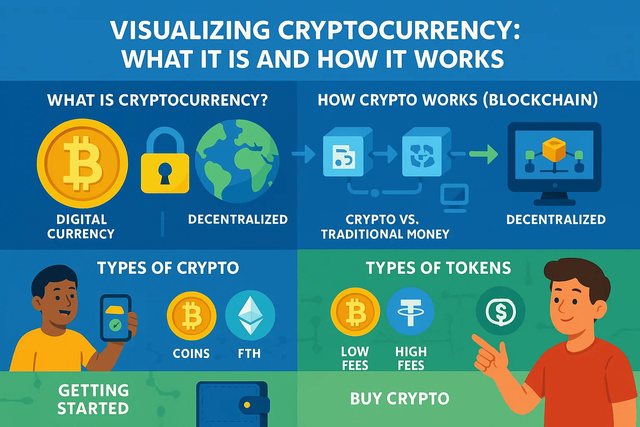What Is Cryptocurrency? A Simple Guide to Digital Money
What Is Cryptocurrency? A Simple Guide to Digital Money
Cryptocurrency is everywhere—but what is it, and how does it actually work? If terms like "blockchain" or "decentralized finance" leave you scratching your head, you’re not alone. Over 400 million people worldwide now use crypto, yet many still struggle to grasp the basics.
This guide cuts through the jargon to explain what cryptocurrency is, how it functions without banks, and why it’s reshaping global finance. Whether you’re curious about Bitcoin, confused by wallets, or wondering if crypto is safe, you’ll find clear answers here. Let’s dive in.
What Is Cryptocurrency?
Cryptocurrency (or “crypto”) is a type of digital money that operates independently of governments or banks. Unlike dollars or euros, it exists purely online and uses cryptography (advanced coding) to secure transactions.
Key features of cryptocurrency include:
- Decentralization: No single entity (like a bank) controls it.
- Blockchain Technology: A public ledger records every transaction.
- Global Access: Send/receive funds worldwide without currency exchange.
The first cryptocurrency, Bitcoin, launched in 2009. Today, over 20,000 cryptocurrencies exist, including Ethereum, Solana, and stablecoins like Tether.
How Does Cryptocurrency Work?
Cryptocurrency relies on two core components: blockchain and mining.
Blockchain: The Digital Ledger
A blockchain is a chain of digital “blocks” that record transactions. Once added, blocks can’t be altered, making fraud nearly impossible. Every crypto user has access to this ledger, ensuring transparency.
Mining: Validating Transactions
Miners use powerful computers to solve complex math puzzles, verifying transactions and adding them to the blockchain. In return, they earn new crypto tokens—a process called proof-of-work.
Not all crypto uses mining. For example, Ethereum uses proof-of-stake, where users “stake” existing coins to validate transactions.
Cryptocurrency vs. Traditional Currency
| Feature | Cryptocurrency | Traditional Currency |
|---|---|---|
| Control | Decentralized (no central authority) | Centralized (government/central bank) |
| Transaction Speed | Minutes, 24/7 | Days (for international transfers) |
| Fees | As low as $0.01 | Up to 3-5% for cross-border payments |
| Security | Encrypted blockchain | Bank/government insurance |
While crypto offers speed and lower fees, it lacks the insurance protections of traditional bank accounts.
How to Buy and Store Cryptocurrency Safely
Step 1: Choose a Crypto Exchange
Platforms like Coinbase or Binance let you buy crypto using dollars. Always verify an exchange’s security features before signing up.
Step 2: Pick a Wallet
- Hot Wallet: Connected to the internet (e.g., MetaMask). Convenient but riskier.
- Cold Wallet: Offline storage (e.g., Ledger). Ultra-secure but less accessible.
Step 3: Start Small
Begin with a small investment (e.g., $20) to learn the ropes. Never invest more than you can afford to lose.
Risks and Benefits of Cryptocurrency
✅ Pros
- Privacy: No personal info needed for transactions.
- Inflation Resistance: Limited supply (e.g., only 21 million Bitcoins exist).
- 24/7 Trading: Markets never close.
❌ Cons
- Volatility: Prices can swing 20% in a day.
- Irreversible Transactions: No refunds for mistakes.
- Environmental Impact: Bitcoin mining uses more energy than Norway annually.
Top 5 Cryptocurrencies to Watch in 2024
- Bitcoin (BTC): The original crypto, often called “digital gold.”
- Ethereum (ETH): Powers smart contracts and decentralized apps.
- Solana (SOL): Ultra-fast transactions at minimal cost.
- Tether (USDT): A stablecoin pegged to the U.S. dollar.
- Cardano (ADA): Eco-friendly blockchain with academic backing.
Conclusion
Cryptocurrency is more than a trend—it’s a revolutionary shift in how we handle money. By eliminating middlemen, it offers faster, cheaper, and more transparent transactions. However, risks like volatility and security threats mean education is crucial before investing.
Ready to explore crypto safely? Learn step-by-step strategies to buy, store, and trade cryptocurrency on CryptoCrafted.org. From wallets to tax tips, we’ve got you covered.
